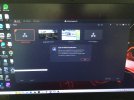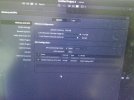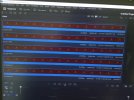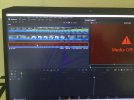You are using an out of date browser. It may not display this or other websites correctly.
You should upgrade or use an alternative browser.
You should upgrade or use an alternative browser.
H.264 versus H.265 mini 3 pro
- Thread starter bersecti
- Start date
No mention of it being the Ti anywhere and when I try and update drivers it says it’s up to date.To be honest... the Nvidia Geforce GTX 1650 Ti (likely Ti as it's the laptop version) is a several year old budget low/medium level gaming d-GPU that still works for 1080p but will most probably struggle with 4K.
Attachments
Maybe I need add a few more pics to let you guys know what stage of incompetence I’m struggling to get past.The GeForce GTX1650 should be capable to do the job without issues. There is something else here. Can be codec.
A lot of guys have been kind enuf to tell me what the free version should be able to render. Mate, I dream about finishing an edit and rendering it! I am getting the Intel Hardware Acceleration pop up when I launch Davinci free.
Attachments
This morning I went and took a few 4K 25fps clips and they are unplayable before I get them to the timeline to mess with.
Although I bumped the frame rate down of course I have forgotten to go back to H.264 and these are all still H.265 after yesterday’s 50fps experiments. This humble beginner thinks there should be an alert on the RC screen telling you that you are now in H.265 and it can be a massive pain in the arse!
So back to the back yard for some actual .264 clips and I’ll post whether my Davinci will play those!
Although I bumped the frame rate down of course I have forgotten to go back to H.264 and these are all still H.265 after yesterday’s 50fps experiments. This humble beginner thinks there should be an alert on the RC screen telling you that you are now in H.265 and it can be a massive pain in the arse!
So back to the back yard for some actual .264 clips and I’ll post whether my Davinci will play those!
Attachments
So I can work with .264 files in 25fps as per the top two. But the lower clip I did first thing this morning at 25 fps but had left in .265 comes up in scary red!
Surely getting rid of the Intel Hardware Acceleration pop up every time I’m opening is my only hope. That tells me DaVinci is still trying to use the onboard Intel graphics card instead of the GeForce yeah? No matter what I set GPU Configuration to in Preferences.
Surely getting rid of the Intel Hardware Acceleration pop up every time I’m opening is my only hope. That tells me DaVinci is still trying to use the onboard Intel graphics card instead of the GeForce yeah? No matter what I set GPU Configuration to in Preferences.
Attachments
Felix le Chat
Well-Known Member
Flat screen computer monitors refresh at 60hz, wherever you are: modern flat screen T.V's automatically switch from 50hz to 60hz depending on the refresh rate of the input. You create problems in playback while you are editing the video. If you don't match the frame rate to the editing computer refresh rate you end up with "odds and evens" - at 60hz (frame rate 60fps) one frame is on screen for 1/60th of a second. At 30fps and 60hz: each frame is on screen for 1/30th of a second and the clip plays smoothly without jitter.So what good reason would he want to playback ‘in the 60hz world’ when natively everything is 50hz here.?
In a professional environment you target the frame rate for the end display device, not by what your laptop or desktop screen is running at. That is the whole purpose of ‘proper’ monitoring displays connected to such devices as Blackmagic’s Decklink boards.Flat screen computer monitors refresh at 60hz, wherever you are: modern flat screen T.V's automatically switch from 50hz to 60hz depending on the refresh rate of the input. You create problems in playback while you are editing the video. If you don't match the frame rate to the editing computer refresh rate you end up with "odds and evens" - at 60hz (frame rate 60fps) one frame is on screen for 1/60th of a second. At 30fps and 60hz: each frame is on screen for 1/30th of a second and the clip plays smoothly without jitter.
The edit suites I built for the majority of the Australian broadcasters, and many of those in the UK, always used a reference monitor to ensure any aliasing effects seen on 60hz desktop LCD displays were not present on the final output sent to mass, high bandwidth storage ready for transmission. You will always see aliasing effects on desktop and laptop screens unless running at the exact frame size as the end product.
Most modern LCD and OLED screens (EU and Asia) used for TV in homes are running at 100 or 200Hz (at best) refresh rate from the 25FPS (50i) input and still run at the same refresh rate at 30/60. The onboard video pipeline processor is doing all the heavy lifting conversion regardless of what you put into it including conversion from interlaced as broadcast to progressive.
If that's really the case... a GTX 1650 (without Ti) in a laptop, then it's actually slightly worse, the Ti is slightly faster.No mention of it being the Ti anywhere and when I try and update drivers it says it’s up to date.
Felix le Chat
Well-Known Member
The huge majority of drone footage shot by hobbyists ends up on YouTube, Instagram, tik-tok etc. So that's phone screens, tablets, computer monitors all refreshing worldwide at 60hz.In a professional environment you target the frame rate for the end display device, not by what your laptop or desktop screen is running at. That is the whole purpose of ‘proper’ monitoring displays connected to such devices as Blackmagic’s Decklink boards.
The edit suites I built for the majority of the Australian broadcasters, and many of those in the UK, always used a reference monitor to ensure any aliasing effects seen on 60hz desktop LCD displays were not present on the final output sent to mass, high bandwidth storage ready for transmission. You will always see aliasing effects on desktop and laptop screens unless running at the exact frame size as the end product.
Most modern LCD and OLED screens (EU and Asia) used for TV in homes are running at 100 or 200Hz (at best) refresh rate from the 25FPS (50i) input and still run at the same refresh rate at 30/60. The onboard video pipeline processor is doing all the heavy lifting conversion regardless of what you put into it including conversion from interlaced as broadcast to progressive.
If you're shooting stock specifically for broadcasters, then yeah, tailor your output to broadcast standard for that region, but the fact remains that all but a very few of us drone jockeys are amateurs producing shorts for other amateurs to look at and those massively compressed shorts are shunted around the globe by internet social media platforms.
I'd love to have a full pro-level Black magic editing setup, but for a 5 minute short showing off my holiday clips: something like that would be like putting designer lipstick on a pig.
Let’s not bother about what frame rate I’m editing or rendering in. Or screen refresh rates. I’m trying to decide at this stage of my learning curve whether to ever record in H.265 modes when I go overseas shortly.
At the moment with the free version of Davinci any .265 files are unusable after import. As a lot of my footage will be of surfing it lends itself well to the odd slow motion bit thrown in now and then. It was my belief that 50 OR 60 fps in 4K was the go for slow motion playback? Is this true?
Thanks for all the advice on handbrake and shutter encoder etc but if somebody here tells me I can get a nice slow motion result from H.264 coded footage @ 25fps that’s what I’ll go for.
I might do a few waves @ 50fps but be aware of the double handling through another app or fixing the free version I’m running by either buying the paid version or throwing my son’s laptop in the dam and buying another machine.
At the moment with the free version of Davinci any .265 files are unusable after import. As a lot of my footage will be of surfing it lends itself well to the odd slow motion bit thrown in now and then. It was my belief that 50 OR 60 fps in 4K was the go for slow motion playback? Is this true?
Thanks for all the advice on handbrake and shutter encoder etc but if somebody here tells me I can get a nice slow motion result from H.264 coded footage @ 25fps that’s what I’ll go for.
I might do a few waves @ 50fps but be aware of the double handling through another app or fixing the free version I’m running by either buying the paid version or throwing my son’s laptop in the dam and buying another machine.
25FPS is too slow for smooth slowmo but 50FPS works well. Although you can’t immediately edit with mixed frame rates on a single timeline in Resolve it’s quite easy to workaround. If you do a Google search for ‘Davinci Resolve mixed frame rates’ you’ll see a couple of examples of how to do it.Let’s not bother about what frame rate I’m editing or rendering in. Or screen refresh rates. I’m trying to decide at this stage of my learning curve whether to ever record in H.265 modes when I go overseas shortly.
At the moment with the free version of Davinci any .265 files are unusable after import. As a lot of my footage will be of surfing it lends itself well to the odd slow motion bit thrown in now and then. It was my belief that 50 OR 60 fps in 4K was the go for slow motion playback? Is this true?
Thanks for all the advice on handbrake and shutter encoder etc but if somebody here tells me I can get a nice slow motion result from H.264 coded footage @ 25fps that’s what I’ll go for.
I might do a few waves @ 50fps but be aware of the double handling through another app or fixing the free version I’m running by either buying the paid version or throwing my son’s laptop in the dam and buying another machine.
Great, so I’m not silly in actually wanting to shoot in 50fps.25FPS is too slow for smooth slowmo but 50FPS works well. Although you can’t immediately edit with mixed frame rates on a single timeline in Resolve it’s quite easy to workaround. If you do a Google search for ‘Davinci Resolve mixed frame rates’ you’ll see a couple of examples of how to do it.
It appears a lot of people have problems with editing H.265 coded stuff though. I don’t mind doing a complete edit on the 50fps stuff to get to 25fps and nice slowmo and then going again with all my 25fps surfing and B roll.
However I’m still at the stage where free Davinci and son’s laptop give me the pop up on start up AND won’t let me edit ANY H.265 files.
Just be brave and shoot a little bit of 50fps stuff on a few nice waves and deal with throwing money at Davinci Studio or even a different NLE and/or a new machine when I get home?
H.265 is too much for many laptops and even some of the most recent models depending on the CPU capabilities and performance. Ideally by now we would have hardware support in all current generations of processors.Great, so I’m not silly in actually wanting to shoot in 50fps.
It appears a lot of people have problems with editing H.265 coded stuff though. I don’t mind doing a complete edit on the 50fps stuff to get to 25fps and nice slowmo and then going again with all my 25fps surfing and B roll.
However I’m still at the stage where free Davinci and son’s laptop give me the pop up on start up AND won’t let me edit ANY H.265 files.
Just be brave and shoot a little bit of 50fps stuff on a few nice waves and deal with throwing money at Davinci Studio or even a different NLE and/or a new machine when I get home?
All video codecs are a compromise in some way and H.265 is one that requires a lot of CPU cycles to decode. The advantage being often smaller file sizes but improved image quality and support for higher resolutions.
Our current DJI drones have hardware support to create H.265 files in realtime.
H.264 is still adequate and requires far less CPU effort to decode.
As mentioned previously current Apple iPads with an M1 processor have no problem editing H.265 and playing back smoothly. The same goes for the current M1 and M2-based Mac, Mac Mini and MacBook Pro models. You may spend a lot of money on several different drones over the next five years but you only need to buy one PC for editing and best to get the one that does the job well with some future proofing. I’m still editing 1080P with DaVinci Resolve (15) on a 2012 MacBook Pro and it works flawlessly.
Thanks so much for explaining that. Coincidentally I started thinking about the iPad option last night. Im on a very old Mini4 99% of the time so after a bit of reading I found out that Resolve 18 is already available for anything M1. Is an iPad ipad upgrade the solution? My wife and son run Windows laptops but if a new M1 iPad Pro upgrade for me means I could take an iPad (albeit it bigger than this little mini4) into the jungle and edit anything the drone can throw at it I think it’s a no brainer.H.265 is too much for many laptops and even some of the most recent models depending on the CPU capabilities and performance. Ideally by now we would have hardware support in all current generations of processors.
All video codecs are a compromise in some way and H.265 is one that requires a lot of CPU cycles to decode. The advantage being often smaller file sizes but improved image quality and support for higher resolutions.
Our current DJI drones have hardware support to create H.265 files in realtime.
H.264 is still adequate and requires far less CPU effort to decode.
As mentioned previously current Apple iPads with an M1 processor have no problem editing H.265 and playing back smoothly. The same goes for the current M1 and M2-based Mac, Mac Mini and MacBook Pro models. You may spend a lot of money on several different drones over the next five years but you only need to buy one PC for editing and best to get the one that does the job well with some future proofing. I’m still editing 1080P with DaVinci Resolve (15) on a 2012 MacBook Pro and it works flawlessly.
Is the only problem with buying my most expensive iPad now that the Pros don’t get the OLED screen till next year? Is the current 11” screen good enough for on the road editing?
The existing LCD is extremely good with deep blacks. The OLED version to come will use less power, be slightly better with contrast and potentially allow an even thinner design or space for a slightly deeper battery.Thanks so much for explaining that. Coincidentally I started thinking about the iPad option last night. Im on a very old Mini4 99% of the time so after a bit of reading I found out that Resolve 18 is already available for anything M1. Is an iPad ipad upgrade the solution? My wife and son run Windows laptops but if a new M1 iPad Pro upgrade for me means I could take an iPad (albeit it bigger than this little mini4) into the jungle and edit anything the drone can throw at it I think it’s a no brainer.
Is the only problem with buying my most expensive iPad now that the Pros don’t get the OLED screen till next year? Is the current 11” screen good enough for on the road editing?
Resolve 18 for the iPad is out now with several big updates in the pipeline. Currently the Fusion, Color and Deliver pages are hidden while final UI changes are made for the iPad screen. However the functionality is already there and you can create keyboard shortcuts to enable the missing pages. All the standard render options are available but you’ll need to enable the deliver page for anything less regularly needed.
All you would need is a memory card reader and a USB C cable to edit out on the road. Add the Apple pen for even more flexibility.
Once you start using the 11’’ iPad you’ll soon realise just house small and comprised the mini’s are.
The existing LCD is extremely good with deep blacks. The OLED version to come will use less power, be slightly better with contrast and potentially allow an even thinner design or space for a slightly deeper battery.
Resolve 18 for the iPad is out now with several big updates in the pipeline. Currently the Fusion, Color and Deliver pages are hidden while final UI changes are made for the iPad screen. However the functionality is already there and you can create keyboard shortcuts to enable the missing pages. All the standard render options are available but you’ll need to enable the deliver page for anything less regularly needed.
All you would need is a memory card reader and a USB C cable to edit out on the road. Add the Apple pen for even more flexibility.
Once you start using the 11’’ iPad you’ll soon realise just house small and comprised the mini’s are.
Are we only talking the larger RAM 16G iPad Pro that can deal with H.265 here?
Will the cheaper IPad Air with 8G of RAM deal with my drone’s H.265 for my slowmo? It’s running the M1 and I have to buy card readers and most likely some external storage. The cost of the Pro with 2TB in it could land me in a divorce court!
Will the cheaper IPad Air with 8G of RAM deal with my drone’s H.265 for my slowmo? It’s running the M1 and I have to buy card readers and most likely some external storage. The cost of the Pro with 2TB in it could land me in a divorce court!
I have the 11’’ M1 Pro with 512GB, which will keep me going for years. I would always recommend as much storage as you can afford.Are we only talking the larger RAM 16G iPad Pro that can deal with H.265 here?
Will the cheaper IPad Air with 8G of RAM deal with my drone’s H.265 for my slowmo? It’s running the M1 and I have to buy card readers and most likely some external storage. The cost of the Pro with 2TB in it could land me in a divorce court!
Blackmagic recommend the iPad Pro M1 or newer. Earlier models may be restricted to HD and memory limitations may limit some features.
The iPad Air M1 is listed as compatible. There is little significant (from an editing perspective) difference between the Air and Pro but the higher refresh rate supported by the Pro models gives the interface a much smoother, fluid feel. It also has a noticeably better audio performance.
solagraphy
Member
Because only your electricity is 50hz not your tv, your computers nor your phones none of them have been limited to 50hz in ages. Any TV made in the past decade and a half and even many older will take more than 25/50hz signals. You were only stuck held to the 25/50 paradigm when we lived in an analog world.So what good reason would he want to playback ‘in the 60hz world’ when natively everything is 50hz here.?
I mean, just about everything does have h265 encoding and decoding though. Any Intel CPU after skylake does. Any NVidia GPU in the GTX 1000 line or newer, any amd GPU/APU made past Polaris. Apple silicone macs all have support, most legacy intel macs have support as well through either their Intel CPU, Amd gpu and some even would get help from their T2 chips. You almost have to be trying not to buy a system with h265 support in the past half decade.H.265 is too much for many laptops and even some of the most recent models depending on the CPU capabilities and performance. Ideally by now we would have hardware support in all current generations of processors.
All video codecs are a compromise in some way and H.265 is one that requires a lot of CPU cycles to decode. The advantage being often smaller file sizes but improved image quality and support for higher resolutions.
Our current DJI drones have hardware support to create H.265 files in realtime.
H.264 is still adequate and requires far less CPU effort to decode.
As mentioned previously current Apple iPads with an M1 processor have no problem editing H.265 and playing back smoothly. The same goes for the current M1 and M2-based Mac, Mac Mini and MacBook Pro models. You may spend a lot of money on several different drones over the next five years but you only need to buy one PC for editing and best to get the one that does the job well with some future proofing. I’m still editing 1080P with DaVinci Resolve (15) on a 2012 MacBook Pro and it works flawlessly.
Last edited:
Similar threads
- Replies
- 12
- Views
- 2K
- Replies
- 4
- Views
- 777
- Replies
- 24
- Views
- 5K
- Replies
- 19
- Views
- 2K















